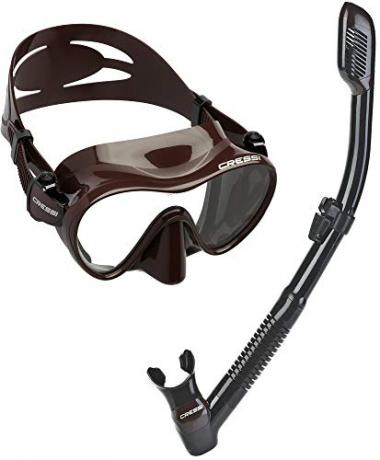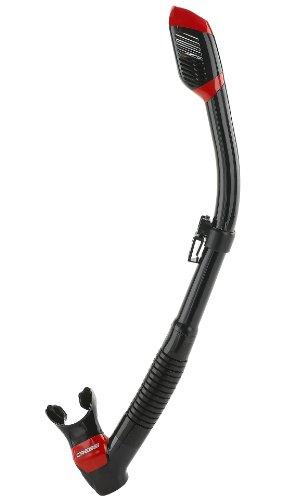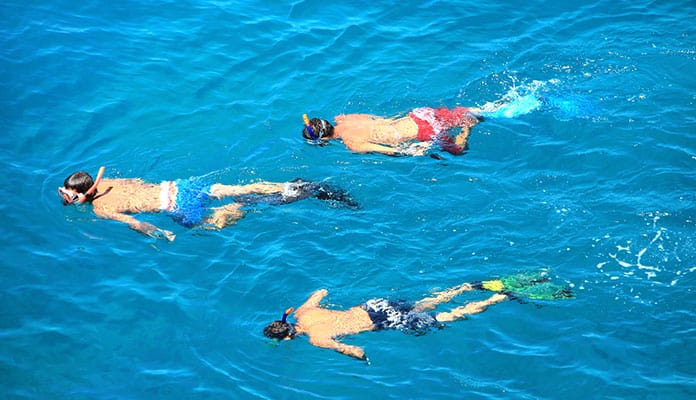
Learning how to snorkel is a fun way to spend a day at the beach. Unlike scuba diving snorkeling is a sport that you can learn by yourself – it doesn’t require a course. It may take a bit to get used to having your face in the water but once you start seeing the sea life swimming below you you’re sure to forget about the weird sensation.
Just as you explore the land of a foreign place when traveling, it can be just as rewarding to explore the water. Snorkeling can be done in both lakes and oceans with plenty of fun exploring. At times, snorkeling can even lead the way to explore through caves and looking at shipwrecks. The life underwater can be just as diverse as that above water and that is why no trip is complete without exploring below the surface. Be sure to grab your snorkel and start your adventure.
Your next vacation can be more than just sitting on the beach. This will give you another activity you can do and even plan vacations around. It is easy to start and once you are comfortable in the water you will be able to go to more difficult places and even explore caves and tunnels.
1. Having The Right Gear
When you are snorkeling, you are out in the water and are therefore exposed to a climate you are not used to. From changing weather patterns to unexpected currents many things can affect your day in the water.
The biggest thing that will affect whether your day in the water is enjoyable is the gear you have with you. Snorkeling is an activity that can be easily learned but if you have a faulty snorkel or leaky mask the day can quickly become ruined. Like preparing for a dive holiday it is recommended to bring along your own gear. Once you understand how each piece of equipment works you will be able to start buying your own. This will give you the ability to go places that don’t have rental shops nearby or worry about returning your gear before they close for the day.
Pro Tip: Many all-inclusive resorts sell cheap snorkel gear. We do not recommend buying these. In our experience, they are cheaply made and can actually be dangerous in the water. The seal around the mask is often rigid and leak while the snorkel is uncomfortable and untrustworthy.
Spend the extra money and head to a snorkel or scuba shop. These people will help you not only fit and size your gear but can also explain where the best spots to check out around you are.
What to wear while snorkeling can be pretty basic. Most often, people choose to opt for a snorkel package that includes everything they need for their day including a mask, snorkel, and fins. This is a great option and a popular choice for many snorkeling enthusiasts. While it is great to buy a quality packaged deal, it is important to know how to thoughtfully pick out your gear and care for it properly.
2. How to Choose Your Mask
When choosing your mask it is important to try it on first. Do this by tilting your head back and resting the mask on your face. Without putting the strap on the back, take a deep breath in through your nose. Tilt your head upright and ensure that your mask stays on your face securely. Notice any leaks in or air coming through your mask – this will turn into water leaking in while you swim. Also, make sure your eyes aren’t cut off as you will want to be able to see everything the underwater world has to offer.
3. How to Choose Your Snorkel
You may be wondering how to choose your snorkel. There are a couple of different types of snorkels including full-faced options, dry snorkels, and a regular option. Each of these options has its benefits and drawbacks and knowing about each one will make your decision easier.
You must make sure that you choose a dry snorkel. A dry snorkel is one that will not allow water to enter through the top. This allows you to take your snorkeling experience even further by diving below the water’s surface. It is also useful if you are snorkeling in a place with choppy waters as it will ensure that water does not get in your snorkel as the waves crash over you. It does this by having afloat near the top of the snorkel. When the water rises above it the float simply raises closing the hole that lets air out.
A full-face snorkel is another option for the mask-snorkel set. This is a large mask that covers your whole face and provides an impressive 180° view. The beauty of this type of mask is that it does not fog up and does not have a learning curve. It also does not require having a snorkel in your mouth causing dreaded mouth fatigue. Instead, the snorkel is built into the helmet and sits on your forehead without holding anything in your mouth.
4. How to Choose Your Wetsuit
Wetsuits are a popular choice that has many uses. Many people think these are only for cooler waters but that is not the case. Many thin wetsuits don’t insulate and instead just add a protective layer against your skin. This will protect you from the harsh sun and will provide a barrier between you and coral if you accidentally brush up against it. As a bonus, wearing a wetsuit adds a layer of buoyancy and can be an ideal choice for people who struggle to float.
Many times the best snorkeling can be found in areas with rocky shores. This is because the coral can easily grow in these areas and the rocks provide shelter for marine life. Wearing a quality pair of water socks will help protect your feet from the slippery rocks that may have sharp edges. These socks are also ideal for use with fins as they can sometimes cause you to chafe and get blisters on your heels.
5. Snorkeling Basics
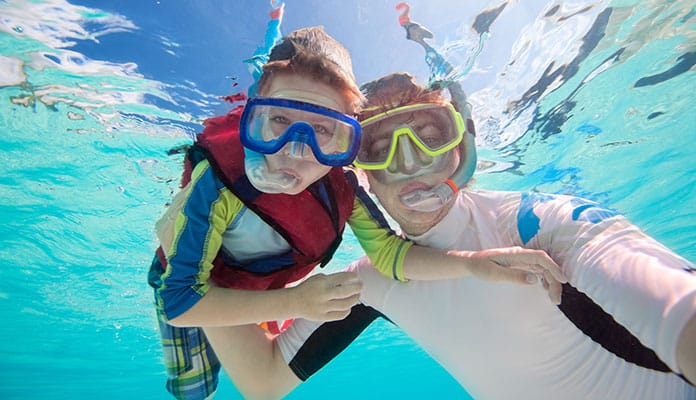
When in the water, it is important to remember that all life underwater is very delicate. Moreover, coral reefs are becoming scarce taking quite a beating from human interactions. For this reason, most reefs are protected and it is important to understand that everything you encounter water should be seen, maybe even photographed, but never touched. Be sure to respect the life around you and be conscious of where your fins kick and never reach out to touch any animals. Remember, you are not there to scare the aquatic life.
Safety
When heading into the water for your snorkeling adventure, it is important to incorporate the buddy system. This does not simply mean getting in the water but actually sticking with a buddy while in the water. This is important, especially when snorkeling in unfamiliar waters. It is easy to get carried away and swim too far or perhaps even get caught in a current. Having a buddy with you increases safety.
While you are likely to get caught up in all the buzzing life below the water’s surface, be sure to stick your head up often to orientate yourself. This is important as it is easy to get carried away and end up far from the shore.
It is important before going out to understand how riptides work. A narrow surge of water that rushes out to the sea and then opens like a fan towards the open ocean. If you feel like you get caught in one of these difficult currents it is important to not try and swim for shore as this is a battle you are not likely to win. Instead, stay calm and swim parallel with the shore to swim out of the rip current. This will get you away from the pull to safer water.
6. Maintaining Your Mask
If you are in the water and your mask gets water in it, it is important to know how to fix it. If this happens out of the water, simply clear as normal. If you are underwater this is simple. Tilt your head back and push the top of your goggles away from your face allowing water to escape from the bottom near your nose. Simultaneously gently blow through your nose to push all the water out of your mask.
Cleaning your mask is another helpful tool to be aware of. While maintaining your gear at home, you can clean your mask with some toothpaste. Simply rub it on the mask and rinse with water to clear up any fog. When in the water, you can simply defog with the help of some saliva. Simply add a bit of saliva to your mask and use your finger to spread. Rinse it in the water and it should come out good as new.
When out in the water it is important to never rest your mask on your forehead. The last thing you will want is your mask accidentally falling off your face and falling to the ocean floor. Not only will you have lost your mask and snorkel but you will also have put yourself in a dangerous situation without your snorkel. Instead, rest your mask by bringing it down around your neck.
7. Your First Time In The Water
You have your gear and you found your perfect snorkeling spot. You are now ready to jump in the water. For your first few times be sure to find a place that has a beach entrance with water that is calm and has no currents. This will make getting in and out of the water easier than say rocks.
Wade out to the water so that it is at chest level when you are sitting. This is when you will put on your fins, mask, and floats. Make sure that your mask is clean and defogged. Once you have your gear on you are ready to start swimming.
To start, simply float on the top of the water. If you are nervous you can strap floats around your waist that will help you to stay on the surface. You are going to want to use your feet to propel you around. Your fins will make it so that a slight kick will move you surprisingly far. Your hands should be tight to your core, perhaps even crossed over your chest. The trick here is to stay horizontal on top of the water doing as little work as possible.
Try to stay calm trying to achieve a meditative state. This is one sport you do not want to go fast in. It is important not to flail and to instead glide smoothly over the water. Fish are very attuned and will get scared away if you splash or make any noise. They will even sense your fear and this will all work towards scaring away all the sea life you are trying to see. Do not kick with your feet out of the water. Fish can hear everything that happens around them and your kicking sounds like a semi-truck on the highway.
The hardest part for most is trusting your snorkel. Having your face in the water can seem unnatural at first but you get used to it quickly. You can adjust the angle at which your snorkel sits out of the water if you find it isn’t sitting straight up. Remember to breathe normally. You never want to hold your breath or take small shallow breaths. This can lead to oxygen deprivation and negative effects.
Pro Tip: Nearly every snorkel has a purge valve. This is a button on the bottom of the snorkel that allows water that has entered to exit. This is done with a one-way valve that lets water out and not in. If you find that you have water in your snorkel and no breath to clear it simply press the purge valve and you will be able to breathe normally again. This ensures you don’t need to change positions and become upright in the water.
Many guided snorkel trips do not have water entrances. Instead, a boat will typically take you out into the ocean to get to better coral reefs. This will require you to enter the deep water suddenly rather than gradually walking in. For this, you will want to have your gear on before you get into the water. This is especially true for your fins. When in the water, act as you would near the shore remembering to look up now and then to ensure you are still close to your boat.
You might also like: Skin Diving Techniques
8. Knowing Where To Snorkel
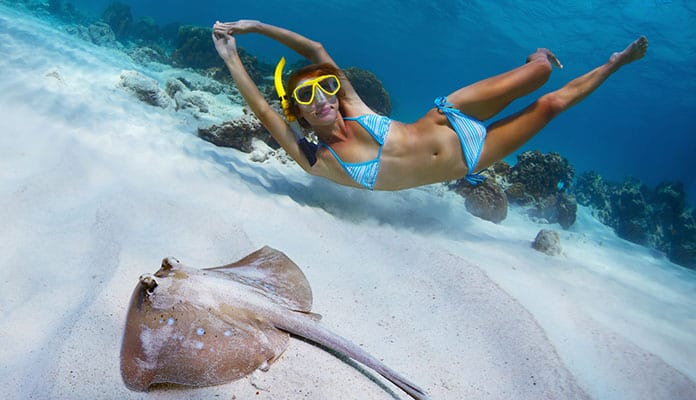 You must know where to snorkel. Respecting the ocean is an important part of the snorkeling experience. There are many things that you will not be able to see but are important to know before snorkeling.
You must know where to snorkel. Respecting the ocean is an important part of the snorkeling experience. There are many things that you will not be able to see but are important to know before snorkeling.
Riptides, changing currents, and unexpected weather patterns all lead way to potentially dangerous situations. For this reason, it is incredibly important to always wear a life vest. It is also a good idea to snorkel in areas with lifeguards especially when you are new to the sport. Choosing spots that have sand are generally the easier entry and exit points as well. You won’t have to worry about teetering on a rock to put your gear on or jumping off a pier and keeping your gear attached to you.
Once you try snorkeling it won’t take long for you to get completely hooked. Soon, your internet search history will be full of quests to find the best snorkeling in the world. When traveling to a new area, it may be a good idea to sign up for a snorkeling tour. A guided tour will help you to find the best spots and get the lay of the land. They will also be able to show you how to navigate through areas and get back to shore safely.
Globo Surf Overview
Snorkeling is an amazing sport that will pull at your heartstrings. Once you experience this water sport you will want to continue snorkeling and maybe even be tempted to try scuba diving. Being able to experience life under the water will open your eyes to a whole new world. Once you get used to snorkeling you can grab a waterproof camera and document what you see. This way you can show your friends and family everything you see underwater.
Snorkeling is an easy sport to start and even easier to fall in love with. Your next vacation to a tropical place doesn’t have to be just sitting on the beach. Now you can jump in the water and swim with dolphins, turtles, or even sharks.
Snorkel Skill Guides:


